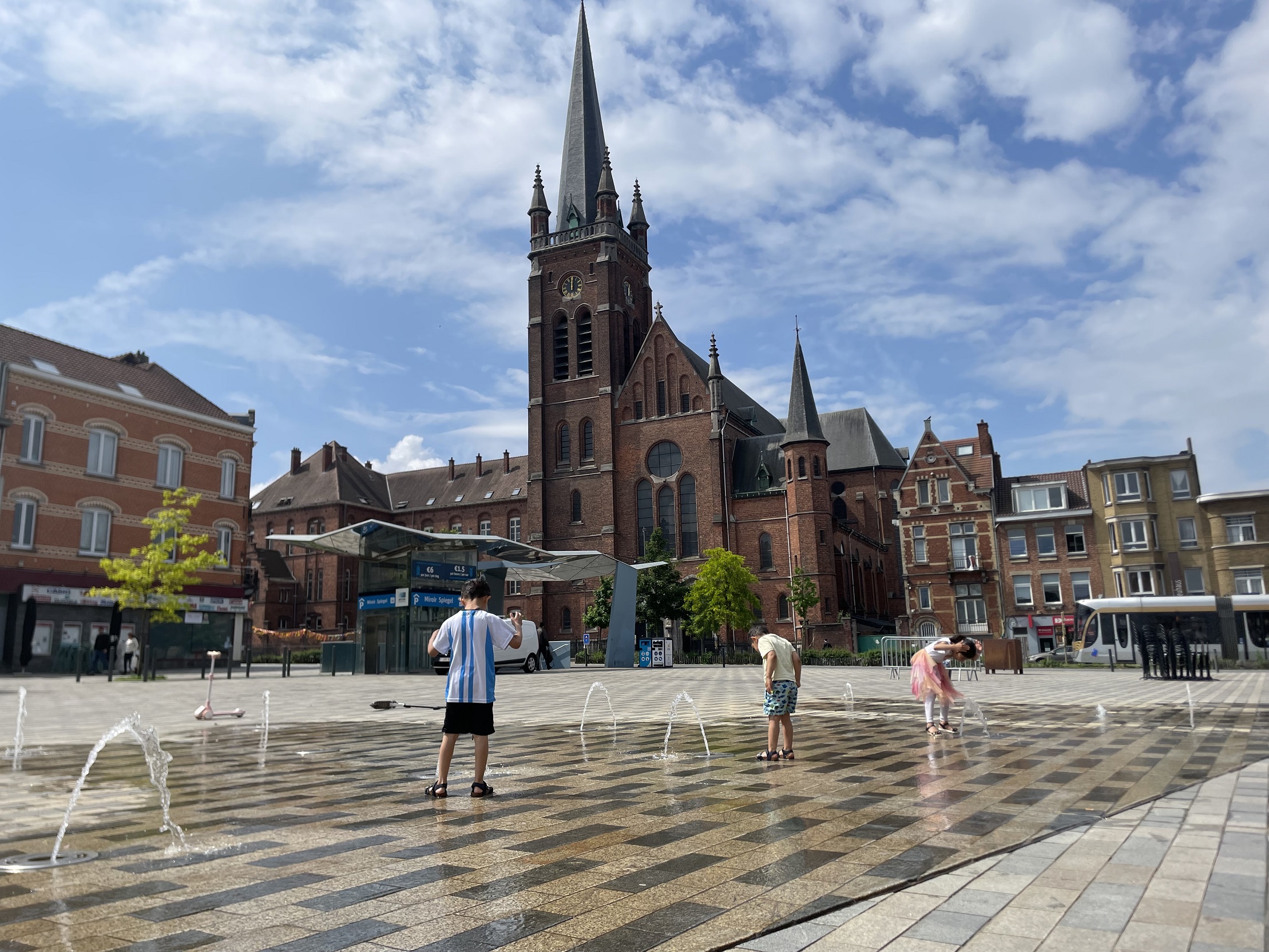The incoming metro at the interconnected Simonis and Elisabeth stations meets tram 9 waiting upstairs. Without needing to surface, you rise to the orthogonal tram stop above, but still below ground. One platform, two buffers, incoming and outgoing trams, all is bright and white-tiled.
The north and west of Brussels, it has always seemed to me, have a slightly different feel to the south and east. Not easy to put your finger on, to be sure, but it has to do with the latter’s monopoly of international and national bureaucracies, the European Union, NATO, the Belgian and regional governments et al confine themselves to central and south-east.
The west, on the other hand, feels more like – am I skating on thin ice here? – a provincial Belgian town. Middle class, multicultural, un-graffitied, tidy, green and blessed with unpretentious restaurants a goodly 20% cheaper than their equivalent on the other side of the tracks.
Back to tram 9, which emerges from underground onto the Avenue du Jette/Jetteselaan. At the first tram stop, Broustin, it is a short walk to the Magritte Museum.
This is not the Magritte Museum in which a large collection of his paintings are housed in the centre of town. This is a small private museum located in the great man’s house in Jette where he resided from 1925 to 1952, before moving up in the world to Rue Mimosastraat in Schaerbeek.
Visitors at 135 Rue Esseghemstraat will be relieved of a small sum of money and left to wander, often quite alone, among artefacts from Magritte’s estate. These include copies of original paintings which have now been lost and destroyed, examples of his advertising work, letters, scribblings, and family snaps. The blinds were down and the curtains severely drawn on the sunny day I visited. This, I assume, was to better protect the exhibits from fading; but it did involve me squinting somewhat at the typed explanations.
Having said that there was one glorious takeaway. I had low expectations for interior decoration left over from the 1930s. But one forgets that one is dealing with a painter, a colourist, a man with an eye. Furniture and decor are very much of their time and the domestic rooms are a harmonious delight. The furniture was returned by the estate to the museum when Georgette, having outlived René by 20 years, died in 1986.
A chat with the curator reveals that the museum is largely supported by the commune, that the house itself is in private hands, and that a goodly portion of its 6,000 or so visitors a year are from the United States where Magritte is revered. The museum is not going to captivate a bored teenager, perhaps, but it is a discrete and charming homage to a great Belgian and a modest man.
Tacos and treats
Next to stop Mirroir/Spiegel there is a large church, St Mary Magdalene, at the end of a larger square, Place Reine Astrid. I confess to an increasing affection for Brussels’ plethora of neo-Gothic suburban places of worship. Built in some number as the still pious population of the city increased in the late 19th and early 20th century, they replaced smaller red-brick chapels.
They lack perhaps the soaring majesty of the great medieval cathedrals dotted around Europe. But they are not without merit. Affecting pointy-topped windows, columns with state-of-the-art metallic bits hidden with plaster masquerading as stone, and often scattered about with fussy decoration - I speak from a Scottish presbyterian perspective - which then gets lost somewhat beneath the soaring roofs, they have their own Victorian integrity. Their height reflects, if not shares, the medieval belief that the higher you build the nearer you are to God.
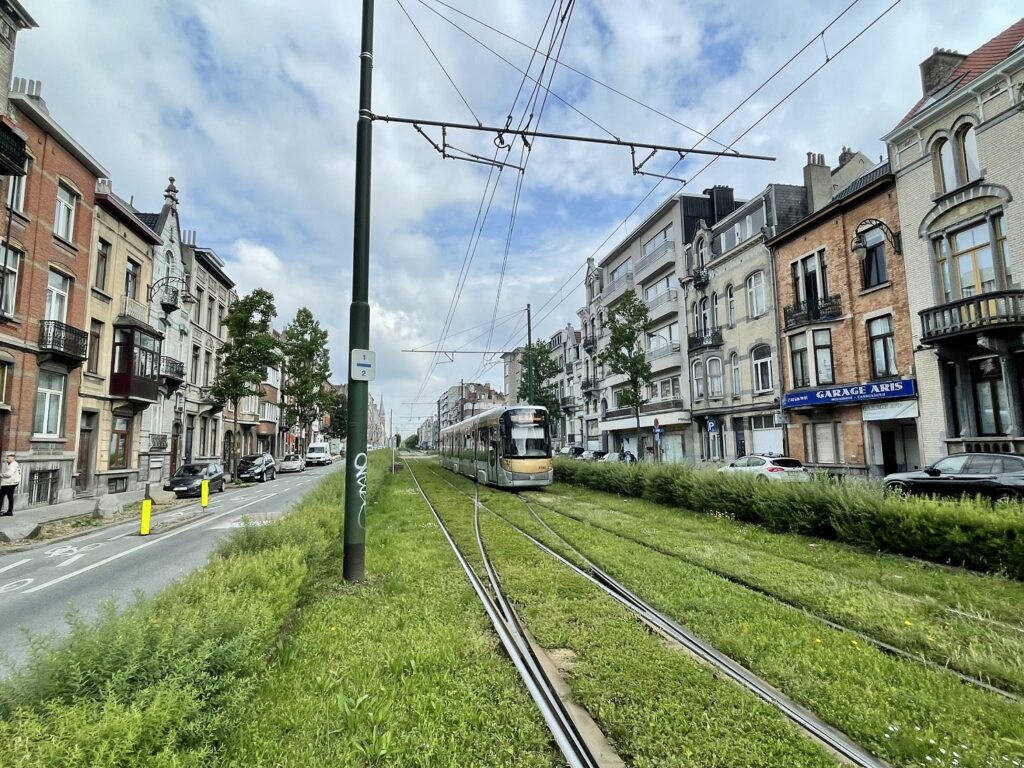
Emerging from underground onto the Avenue du Jette
One such is the St Mary Magdalene. Various side buildings offer a Christian haven for the homeless and impoverished. Translating from the Dutch: “A cup of coffee or tea, a bowl of soup, a chat, a game of ping pong, the use of our computer, or just a lie-down. Be welcome.” And in the church, built in 1905, the interior is offered to those whose homes are unsuitable for study: chaotic family, noisy stairwell? That seems to me an excellent use of an otherwise underemployed, quiet, heated space!
Opposite the church is Place Reine Astrid. Named after a long-ago tavern of ill-repute for the youth of Jette and Molenbeek it is, I’m guessing, 20 metres by 120, and, it is fair to say, that there is not much you can’t purchase in its emporia.
Five cafes (at least), one sushi bar, two pretty spiffing patisseries, a pharmacy, a supermarket, not one, not two, but three phone shops, one of those new, go-to frituurs like the better-known mecca in Place Jourdanplein, a merry-go-round, a travel agent (rare as hen’s teeth these days), a couple of market stalls selling veggies, a paper shop (likewise hard to find), another of those suddenly ubiquitous O’Tacos, a wine bar, an expensive jewellery store, a supermarket, a fancy hair salon with a sullen Twiggy emblazoned in the window, a sophisticated-looking wine bar and - most mysterious of all - a Moroccan restaurant called O’Tweat!
Whether the name was chosen to ride on the coattails of the neighbouring O’Tacos’ higher profile or to attract Irish visitors eager for a mutton stew and cabbage tagine, is hard to tell. And as if that were not enough the square has a full-blown market every Sunday creating bewilderingly un-followable traffic deviations! There is a truly excellent Vietnamese restaurant right opposite the church which was going like a dingbat the Sunday lunchtime I dropped in for a quick pho.
Along tram 9’s journey northwest towards Roi/Koning Baudouin on the left-hand side, “in the direction of travel” as the tram announcements have it, at stop Square du Centenaire/Eeuwfeestsquare, peeping over the trees and houses, is the Koekelberg Basilica. One should not be too surprised at the basilica’s visibility over much of the journey.
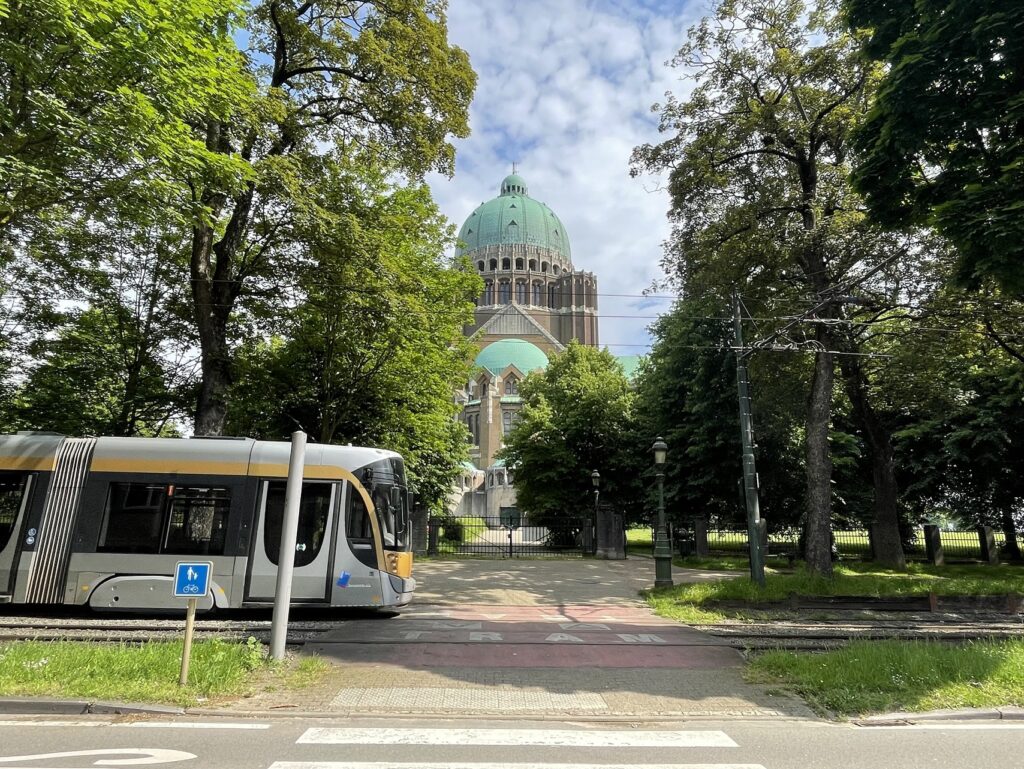
The Basilica, southern face
It is ranked the fifth biggest church in the world after Notre Dame de la Paix in the Ivory Coast, St Peter’s in Rome, St Paul’s in London and Santa Maria del Fiori in Florence. It was 65 years in construction; not least because the style got switched from neo-Gothic to the more vernacular and up-to-date Art Deco. However, 65 years is but a blink of an eye compared to the great medieval Gothic cathedrals and the interminable shenanigans of Gaudi’s Sagrada Familia in Barcelona.
The woods in the city
The tram now rattles down the hill to stop just prior to a 19th century railway bridge at Exposition/Tentoonstelling. To the right is the King Baudouin Park ‘Phase 2’. I recall reading a Bill Bryson travelogue in which he was somewhat sniffy about the lack of green space in Brussels. Residents, I dare say, may beg to differ! And certainly this, to a degree, featureless side of Brussels is quite astonishingly green.
An agreeable stroll around this part of King Baudouin Park, with its pond neatly bordered by aquatic plants to encourage bird- and insect-life, did not hint at the clever linking up of the original part of the park, Poelbos, Dieleghem, and Laerbeek into one 6km green corridor along the Molenbeek Valley.

King Baudouin Park
After a steep incline to Ancienne Barriere/Oude Afspanning which need not detain unless one has a strong urge to buy a Mercedes or a motorbike, the tram then stops at UZ Brussels University Hospital, one of Brussels’ large teaching hospitals and closely associated with the Vrij Universiteit Brussel (VUB).
In linguistically fraught Brussels, it claims Dutch as its working language while hastening to reassure all that the care is multilingual. To a degree the hospital looks to the Flemish hinterland, which starts a couple of hundred metres away on the other side of the ring road, as its market. Its website is impeccably clear that care is “patient centred”.
Built in 1977 it has acquired itself a global reputation for IVF treatment. It makes the point that in its early days, such treatment was considered immoral by some in Belgium, but UZ forged ahead anyway. It did, however, cause a bit of a stooshie a couple of years ago when it refused care to a heavily pregnant woman, an uninsured asylum seeker, unless she produced €2,000 in cash. The hospital later apologised, the employee concerned was “sanctioned”, and the woman was cared for elsewhere.
The hospital claims to keep its costs as low as possible without endangering care. It has about 4,000 employees and 700 beds, admits some 30,000 people a year and treats as many out-patients. Its A&E is considered the largest “in Flanders”. Its car park alone, visible from the tram, is pretty darn impressive.
By the time the tram reaches Arbre Ballon/Dikke Beuk Brussels is opening out slightly and the steady B-flat hum of the ring road is audible in the distance. There are the Laerbeek Woods which spread over both sides of the motorway and cover, I estimate, some four square kilometres. Access near the tram stop is not that easy as the paths climb up the muddy and slippery slope into the dense trees.
A stern notice forbidding dumping is, sad to relate, surrounded by ordure. However once up and into the woodland one could imagine one far enough from civilisation. Only by close study of the map later did I realise that upon entering the woods I had crossed Belgium’s invisible fault line and was now officially in Flanders. Which is presumably why the land was never built upon.
The tram is now approaching its destination. It wanders through a district which must have Corbusier’s purring in his grave: a quartier of massive flats, greenery and rather elegant landscaping is bordered by the ring road to the north and the Arbre Ballon/Dikke Beuk to the south. Punctuated by an ultra-modern high-design supermarket with 7/7 emblazoned in trendy mat-black letters three metres high the whole area feels like - deep breath - Singapore! Ok, ok, it’s not hot and steamy, nor is it as flat as a pancake, nor do palm trees sway but something about its well-organised, white, clean-looking, high-rise flats surrounded by greenery, gardens, pathways and copses recalls the City State.
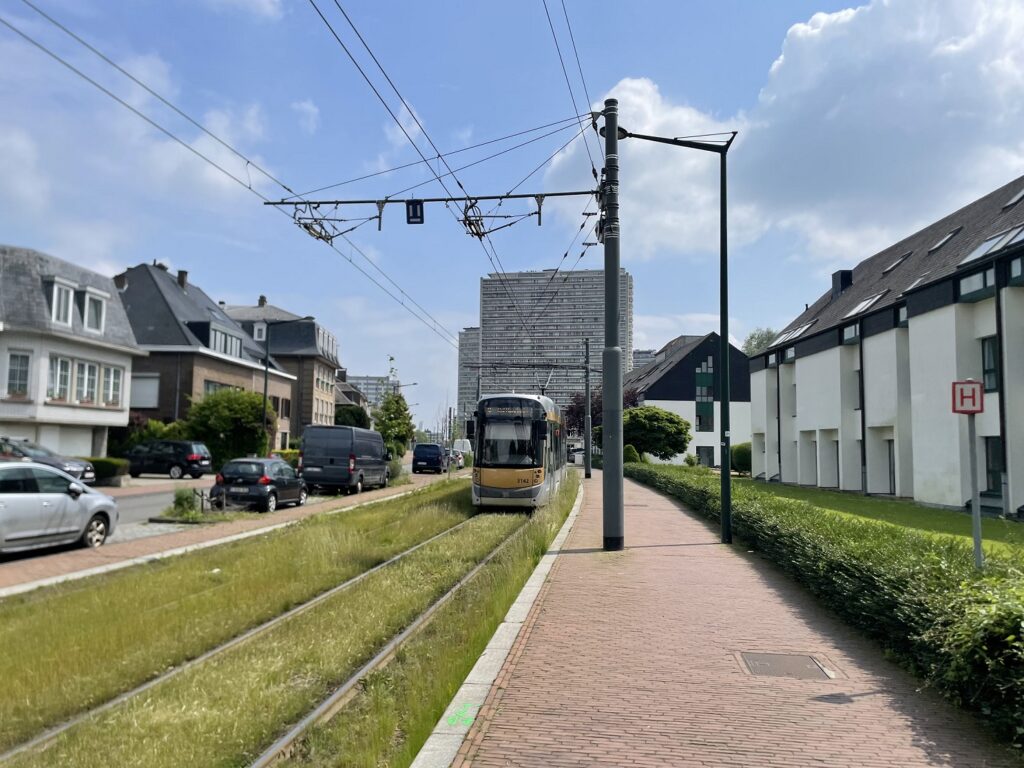
Almost Singapore, Avenue de l'Arbre Ballon
Of course, Brussels and Belgium do not have Singapore’s ruthless efficiency. But somehow, with all Belgium’s political complexities, the Jette and Brussels city elders have contrived to fashion something agreeable and aesthetically pleasing at about 11 o’clock on the city’s clock face. And that over the last 30 years or so. Which strikes me as wholly commendable.
It now veers towards Heysel/Heizel, with a stop in front of the King Baudouin Stadium (Stade/Stadion), with its terminus a little bit further along Avenue Houba de Strooper (Roi Baudouin/Koning Boudewijn). This effectively makes the tram 9 another route for Rolling Stones and Red Devil devotees to make it back into town.

The terminus at King Baouduin Stadium
I could have, had I wished, hopped off the tram and returned to Elizabeth/Simonis and on into town by metro. But travelling by tram is less bumpy than by bus, less stygian than by metro, and less dementing than by car.
Vertigo and The Third Man
My eagle-eyed editor had noticed that from July, tram 9 is to continue its journey beyond Simonis, past the vast Basilica, and on to the little Flemish village of Groot-Bijgaarden to the west. This is currently being served by tram 19. Would I care to take a look at the incipient extension? I would!
Perversely I opted to walk the first two stops up the handsomely wooded Elizabeth Park, which leads to it from the tram’s departure point, the Simonis tram stop. This felt vaguely like the iconic final scene in The Third Man: the grit pathway, the tall trees, the distant sounds of the city, the looming religiosity, and, awaiting me, a gardener leaning against his jeep, missing only Trevor Howard’s iconic duffel coat and beret!
The steps up to the three-metre-high main door of the church were weed-infested and the doors clearly unused. I set off clockwise around the clunky building the size of an aircraft carrier – “never walk widdershins around a church” – and found a way in. I entered and, I do not exaggerate, I gasped.
The size is more impressive inside than out, of course. But it is so much more than that. The delicacy on such a scale, if that’s not a contradiction, the sublime staircases, the multiple shades of caramel, the silence (the other 15 or so visitors could be on another planet), the stained-glass windows, the highly polished wood, and, dear God, the potential heating bills all amazed. It is fair to say that the building stands up to the great gothic cathedrals, Milan, Cologne, Canterbury and Rome, but with a lightness of touch which the other estimable super-churches could never aspire to.
The basilica boasts two museums and a restaurant (only in Belgium!). One of the museums was open - Modern Religious Art - and I resolved to see it after taking in the 52-metre-high viewing gallery with, it is said, a superb vista over central Brussels. I shelved out €8 for the lift, soared aloft, and stepped outside. Big mistake!
Vertigo hit me like an express train. I stepped hastily back inside. The lift, plexiglass see-though, was no longer an option. I slid down the three flights of stairs on my seat keeping as far from the bannisters as I could. I exited sweating and palpitating and threw myself onto good solid earth, to the alarm of two kindly Midwesterners on vacation.
They called upon their God to bless me and, once they were assured that I was not injured, were on their way. I lay on the grass and waited for my heartbeat to drop below lethality. As I did so I wondered vaguely at the 60 or so cars parked in the church car park. Was the local curia grafting industriously in hidden-away offices secreted about the 150,000 or so cubic metres of vastness? I was in no mood to find out!
Go-carts and castle
I rejoin the soon-to-be tram 9 at stop Boissaert-Basilique as it plunges down Avenue Josse Goffin. This is a classic Brussels turn-of-the-century street with four-story-high townhouses, doors direct onto the street and a slightly dusty air. Looking for excitement I notice a building with UNESCO emblazoned upon it. I alight.
I walk through the gates. Security there is none. I gaze at the unremarkable building, wonder at its purpose, ponder my next move and notice two pretty teenagers chatting in Dutch on my right. On my left is a middle-aged woman giving me the evil eye. I realise I am in a school precinct which, you will allow, is no place for an elderly gentleman with time on his hands at 11am. I curse my stupidity, retreat, and curse it again as I notice the stop where I alighted, and am now boarding, is called College Sacre Coeur/Heelig Hart!
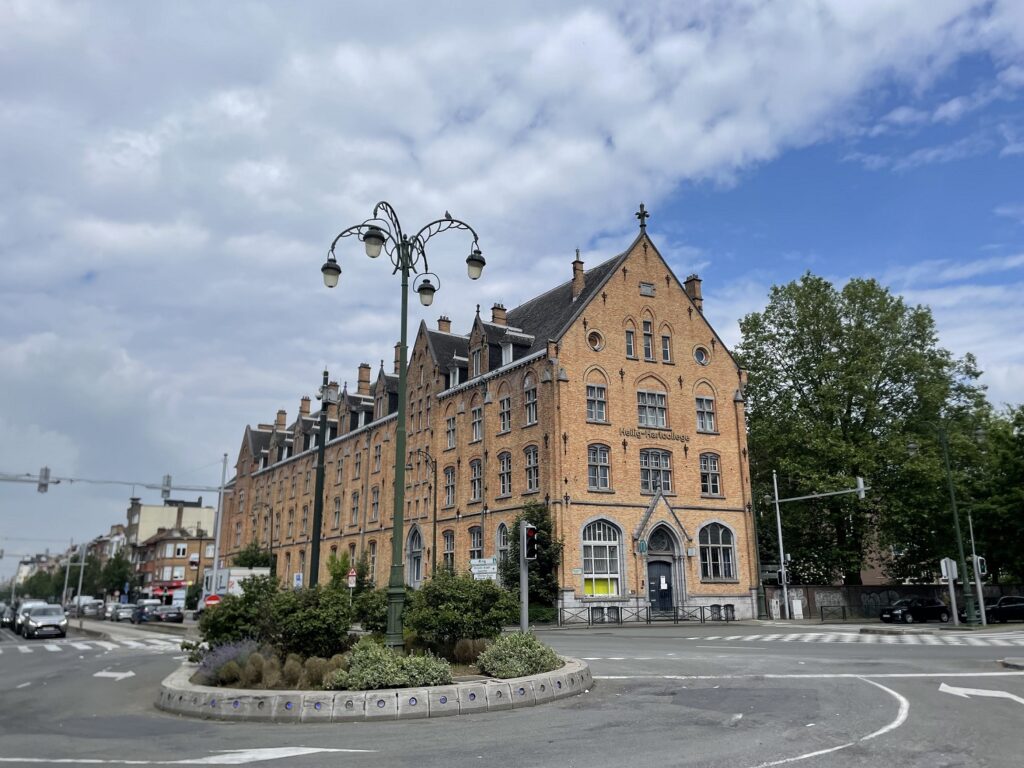
College Sacre Coeur next to the Basilica
The tram then switchbacks up to the large Place Schweitzer, handsomely bedecked with flowers, and then heads downhill to Groot-Bijgaarden. The houses are early 1930s and now have tiny front gardens. At the bottom of the long hill is a roundabout and the tram stop Hunderenveld. Still just inside Brussels the variety of transport choices here is bewildering.
Apart from the humble tram, and in rising levels of exoticness, you have nearby the 87 bus, De Lijn Flanders busses heading for points east, Groot-Bijgaarden railway station, Brussel Kart go-carting track and brasserie, and - yes - a functioning helipad. All an easy spitting distance away.
As the tram comes to a halt at the industrial suburbs, alongside the aforementioned railway station, the one mode of transport still missing is a shuttle bus to the beautiful, green, historical part of Groot-Bijgaarden the other side of the ring road. There, a clutch of fine restaurants – the type that establishment British journalists, in their feverish, anti-EU mode and with an unerring eye for a cliché, would describe as “Brussels’ groaning tables” – surround the elegant 12th century castle.
The tram driver (known in the past in Belgium as a wattman) nods permission for me to stay on board as she swaps ends and I head for home.

